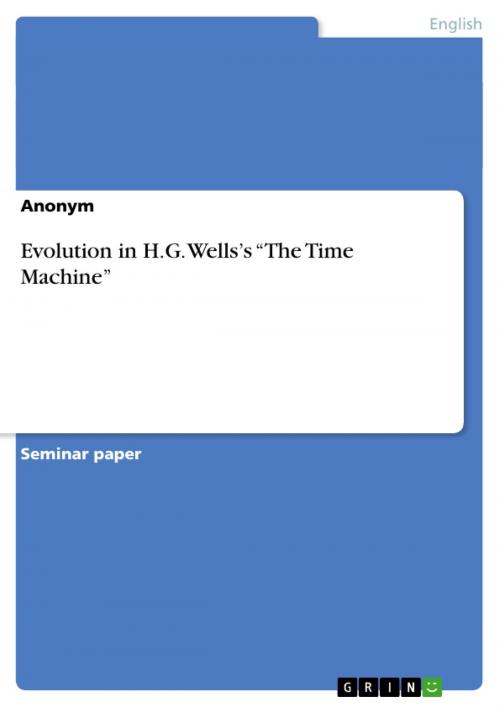Evolution in H.G. Wells's 'The Time Machine'
Fiction & Literature, Literary Theory & Criticism, British| Author: | Anonymous | ISBN: | 9783640469161 |
| Publisher: | GRIN Publishing | Publication: | November 11, 2009 |
| Imprint: | GRIN Publishing | Language: | English |
| Author: | Anonymous |
| ISBN: | 9783640469161 |
| Publisher: | GRIN Publishing |
| Publication: | November 11, 2009 |
| Imprint: | GRIN Publishing |
| Language: | English |
Seminar paper from the year 2009 in the subject English Language and Literature Studies - Literature, grade: 1,0, University of Erfurt, course: Dystopia: Wells and Huxley, language: English, abstract: H.G. Wells had been intrigued by speculations about the future progress of humanity towards a more equal society since his youth. (RUDDICK, 2007: 198) Studying at the Normal School of Science he came into contact with the mind-set of Thomas Henry Huxley who militated against the Social Darwinist thoughts which used evolutionary theories and were present in the late-Victorian society at the end of the 19th century. Huxley became an adored men-tor and friend for Wells who transferred and enhanced his ideas in his literature. (JANSING, 1977: 54) The scientific romance The Time Machine, which was Wells's first novel (GLENDENING, 2007: 7), explores the adventures of a respectable late-Victorian scientist within this evolutionary and Social Darwinist context. The scientist travels with his own created time machine into the year 802,701 where he finds the world of Eloi and Morlocks. These two species represent a degen-erated form of man whose retrogression results from socio-economic condi-tions. An additional journey 30 million years forward in time adds to the image of degeneration in the evolutionary process. This research paper concentrates on the evolutionary and Social Darwinist theme of The Time Machine. First, an introduction to Social Darwinist thoughts in the end of the 19th century is given in order to set the context for this scien-tific romance. Secondly, the cognition process of the Time Traveller is analysed as this will make clear Wells's examination with the social theories of his time. Studying selected symbols and images finally shows a detailed insight into the evolutionary subject of The Time Machine.
Seminar paper from the year 2009 in the subject English Language and Literature Studies - Literature, grade: 1,0, University of Erfurt, course: Dystopia: Wells and Huxley, language: English, abstract: H.G. Wells had been intrigued by speculations about the future progress of humanity towards a more equal society since his youth. (RUDDICK, 2007: 198) Studying at the Normal School of Science he came into contact with the mind-set of Thomas Henry Huxley who militated against the Social Darwinist thoughts which used evolutionary theories and were present in the late-Victorian society at the end of the 19th century. Huxley became an adored men-tor and friend for Wells who transferred and enhanced his ideas in his literature. (JANSING, 1977: 54) The scientific romance The Time Machine, which was Wells's first novel (GLENDENING, 2007: 7), explores the adventures of a respectable late-Victorian scientist within this evolutionary and Social Darwinist context. The scientist travels with his own created time machine into the year 802,701 where he finds the world of Eloi and Morlocks. These two species represent a degen-erated form of man whose retrogression results from socio-economic condi-tions. An additional journey 30 million years forward in time adds to the image of degeneration in the evolutionary process. This research paper concentrates on the evolutionary and Social Darwinist theme of The Time Machine. First, an introduction to Social Darwinist thoughts in the end of the 19th century is given in order to set the context for this scien-tific romance. Secondly, the cognition process of the Time Traveller is analysed as this will make clear Wells's examination with the social theories of his time. Studying selected symbols and images finally shows a detailed insight into the evolutionary subject of The Time Machine.















